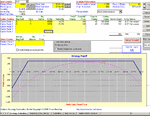Thanks Richard. In that case you can't know many option traders! 🙂
The question has been asked as to whether it is better to pay for a long put which has cost 100 (£1000) by selling a single call at 4225 for 100, or to sell 2 x 4375 calls for 51 (£510). Whilst I have explained my thinking above, a picture is worth a thousand words!
Below is one end of the pay-off diagram (the risky end!). Based on Fridays prices, you could sell 4225 calls for 100, and 4325 calls for 51. As you can see from the diagram, by selling a single 4225 call (heavy red line), at expiry, you break even at all levels below 4225, and start to go into profit below 3725 (not shown) as the put acquires value.
If instead you sell 2 x 4375's (heavy blue line), at expiry you break even at all levels below 4375, and still go into profit below 3725. You are better off by selling 2 calls at all levels below the point at which the 2 lines cross, which in this case is at 4525. Above 4525 you will lose more heavily by selling 2 calls. The decision as to which is best depends upon your own view of where the index is likely to go, and of course there is a greater margin requirement to sell 2 calls than just one.
The thin red and blue lines show the position of each strategy as at Friday, and these will tend to steadily merge with the expiry lines over time. This means that if the position moves against the holder in the short term (i.e. the index rises), but not above the strike prices of the calls, then there will be no loss provided that you can afford to wait until expiry, or wait for the index to fall again. This is not so viable if you hold a future direct. Likewise, if the index falls in value, then there is an immediate profit, but one that will fall as time passes for any given level of the index. If the index is above the strike price of the long put - 3750 - then the profit will disappear completely by expiry. The best result is for there to be a quick movement in the right direction, downwards in this case, and then close both sides of the position. Don't concentrate too much on the expiry position - think about how, and where, profits can be taken or losses cut before expiry.
Incidentally, to demonstrate the effect of low Implied Volatility (IV), the 4225 calls can be sold for 100 at the moment, and for which the IV is 13.4%. If the IV was 25%, the price would be close to 200. So if IV increases above the current very low levels back to nearer the norm of 25%, then the cost of buying back the calls at current levels of the FTSE this far from expiry would be approximately double the current level. Likewise, a holder of long calls could see the value of his holding double with little or no movement in the underlying index purely based on an increase in IV.
This is why I say that options are as much a play on volatility as on direction!


